

Philips 5K2K monitor review: big, sharp and pricey
The 40B1U6903 is a 40-inch office monitor with a high pixel density – and a high price tag to boot. It offers numerous connection options and plenty of work space.
Only a handful of monitors out there are equipped with a WUHD resolution (5,120 × 2,160 pixels). The Philips 40B1U6903 is one of them. As a result, it has an advantage over other widescreen displays, which usually only come with a 1440p resolution and a pixel density of 108 pixels per inch (ppi). The 40B1U6903, on the other hand, manages 140 ppi. Subsequently, fonts and fine details are supposed to look much sharper.

I’d class the 40B1U6903 as a premium office monitor – pretty expensive, but not quite in the same league as graphics monitors with extremely high colour fidelity. Here’s a summary of the most important specs:
- 39.7-inch diagonal, 21:9 format
- 5,120 × 2,160 Pixel, 140 ppi
- matte IPS panel, 2500R curve
- maximum brightness of 300 nits
- contrast ratio of 1000:1
- 100% sRGB and 98% DCI-P3 colour space coverage
- 4-millisecond grey-to-grey response time
- 75-Hz refresh rate
- Integrated webcam
How does the monitor fare in working life? To find out, I spent a month putting it through its paces.
Design and ports: THIS is how it’s done
I’d say this large Philips monitor has been well designed. The housing is simple and black, and though the edges around the picture might not be the thinnest, they look thin enough for a screen of this size. I don’t have any quibbles with the ergonomics: the height of the 40B1U6903 is adjustable, and the monitor can be tilted and rotated. The subtle curvature of 2500R suits me perfectly for this type of monitor.
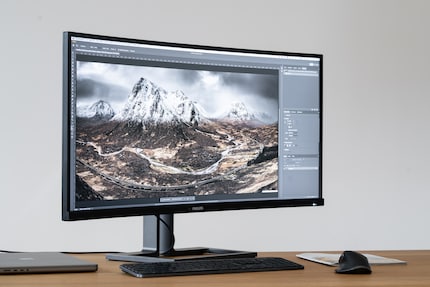
Source: Samuel Buchmann
Something I particularly like is the anthracite-coloured, metal base. While its shape makes the screen seem less gargantuan, it still holds the monitor firmly in place on the desk. Because the base has been so well crafted, the screen doesn’t wobble at all when I type or bump into the desk. Other manufacturers would do well to imitate this kind of stability. Looking at you, Samsung.
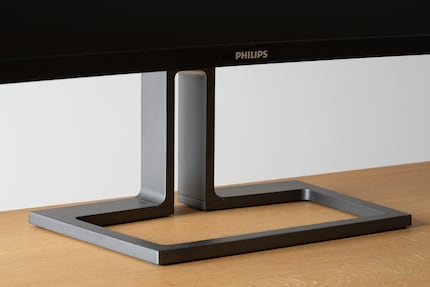
Source: Samuel Buchmann
Another area where Philips has got everything right is the connections: two HDMI 2.0, one DisplayPort 1.4 and one Thunderbolt 4. The latter supplies 90 W of power to any connected laptops. That’s more than enough for any of the latest MacBooks. In addition, the monitor can be used as a docking station. It has Gbit Ethernet, an audio output, two USB-C and four USB-A ports. These days, you can’t ask for any more.
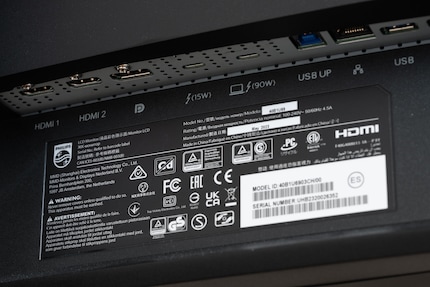
Source: Samuel Buchmann
Brightness and contrast: average
The Philips 40B1U6903’s maximum brightness and black levels aren’t exactly premium. I measured 259 nits on the brightest setting, which should be just about enough for most workstations. Even so, a little extra brightness wouldn’t go amiss in this price range. Still, the monitor I’m testing is more or less evenly lit. The largest difference in brightness, recorded between the middle and the corners, is nine per cent.
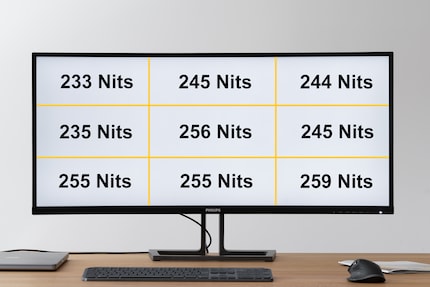
Source: Samuel Buchmann
When it comes to contrast, it’s a similar story. The LED backlight without local dimming reveals this technology’s classic weaknesses: washed-out blacks and obvious blooming. I measure a contrast ratio of 1040:1. Since the anti-reflective coating works well, the perceived contrast does the job in office settings. If you’re watching films or gaming, however, it’s no picnic.
A very good compromise between sharpness and work space
Forty inches in 21:9 format is like having a stretched out 32-incher. I like the height of the screen. It’s particularly useful when working with text. I usually divide the monitor into two halves, each with a comfortably sized window. The only thing that bothers me about this set-up is that I always have to look either left or right, but never straight ahead. To do that, I’d need to split the screen into three, which creates very narrow windows. Mind you, I have the same issue with every 21:9 display.
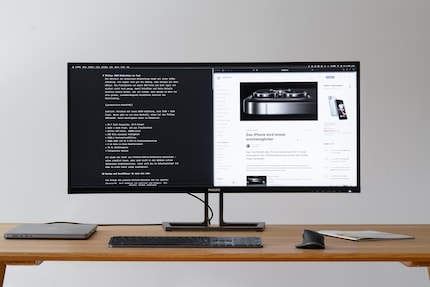
Source: Samuel Buchmann
Due to the size of the monitor, the pixel density is lower than that of, say, a 27-incher with 4K. And this despite its high resolution. That being said, at 140 ppi, it’s still very good in my book. Viewed at a distance of one metre, text and images look clear and sharp. This combination of size and good pixel density is the 40B1U6903’s main strength.
On MacOS, the native screen scales are too small or too large for me at this pixel density. With this in mind, I scale the size of the user interface to «like 3200 × 1350». This adjusts the text to a comfortable size, while still giving me enough work space. Incidentally, the Philips monitor has no trouble connecting to my M1 Max MacBook Pro. It’s recognised every time, dutifully rousing itself from standby whenever I wake up the computer.
Gaming isn’t a strength of this Philips 40-incher . Like any IPS panel, the 40B1U6903’s isn’t exactly responsive. Meanwhile, its 75-hertz refresh rate is a little on the low side. As a result, fast games are blurrier than I can tolerate. I also notice the mediocre contrast when gaming more than I do during office use. Still, the monitor fares well during real-time strategy games.
Colour: on point for its target customer
The 40B1U6903 isn’t a graphics monitor. At this price, however, there’s still an expectation of good coverage across the most common colour spaces. Fortunately, this is what the monitor delivers. Since it covers 98 per cent of the DCI-P3 and 100 per cent of the sRGB colour spaces, it’s good for editing images and videos for digital use. AdobeRGB, on the other hand, is only covered up to 90 per cent. If this is the colour space you work in, the 40B1U6903 won’t be the right monitor for you.
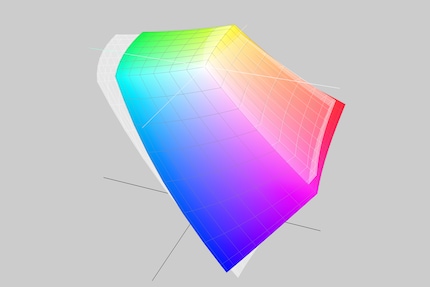
Source: Samuel Buchmann
I’m really pleased with the colour fidelity. When the monitor’s in sRGB mode, I don’t notice any major shifts. Calibrating it with the X-Rite i1Display only provides a slight increase in saturation, something I could also achieve by adjusting the hardware settings. There are no other fine-tuning options.
Features and controls: stripped back, but good
The 40B1U6903’s actual controls are fairly old-fashioned. I navigate through the menu using four buttons on the bottom right of the screen. When doing so, I need to hold the frame still with my thumb, otherwise the monitor wobbles every time I press a button. I’d have preferred a joystick on the back.
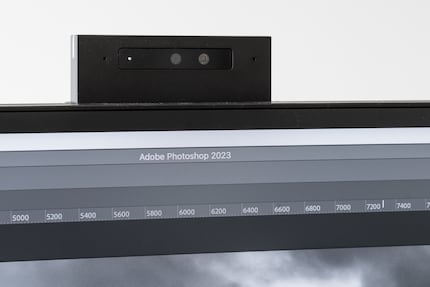
Source: Samuel Buchmann
These stripped back controls have their advantages. Unlike with other brands, there’s no SmartOS or other unnecessary bloatware. If you want to simulate having two separate screens, you can do so with the picture-by-picture mode, which you can activate in the menu. I can also pull out the built-in webcam whenever I need it. The rest of the time, it stays tucked away inside the housing. Pretty elegant, if you ask me.
The disadvantage of this design is the webcam’s small image sensor, which manifests as average picture quality. For everyday video calls, however, it’s not an issue. This is more than I can say for the microphone and built-in speakers, which sound tinny and make for a less-than-enjoyable experience. I’d only ever use them in a pinch.
Verdict: solid premium monitor for office use
While the Philips 40B1U6903 may not be an exciting monitor, I like working on it. It delivers an excellent combination of size and pixel density, and offers good colour accuracy. Another major plus is its variety of connection options, which cut out the need for a docking station for my MacBook. Plus, the monitor’s pull-out webcam spares me from having to use an external one. While we’re on the topic of Macs, the 40B1U6903 is a shining example of a monitor that works well with Apple computers.
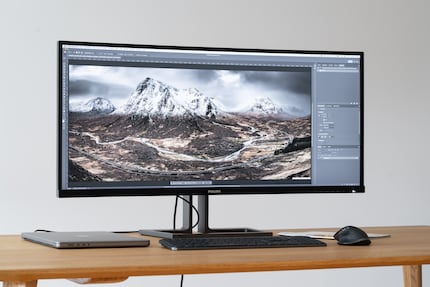
Source: Samuel Buchmann
The cracks begin to show when you look at the monitor’s peak brightness. At just 259 nits, it’s decidedly average. The same goes for the contrast, which is down to the panel technology. During everyday use, I mostly notice this when watching a full-screen video or opening a game. In these situations, the blacks look washed out in dark scenes and blooming occurs at hard contrast edges. Even discounting all this, the monitor’s response time and refresh rate make it unsuitable for gaming anyway.
This Philips 40-incher doesn’t have much in the way of competition. We only sell seven monitors with the same size and resolution. Most of them have the same panel as the 40B1U6903, and are similarly priced. I do, however, like Philips’ design the best. Not only that, but the monitor stays super stable when set up on a desk. If all you’re looking for is an office monitor with plenty of work space, I can recommend the 40B1U6903.
Header image: Samuel Buchmann
My fingerprint often changes so drastically that my MacBook doesn't recognise it anymore. The reason? If I'm not clinging to a monitor or camera, I'm probably clinging to a rockface by the tips of my fingers.




